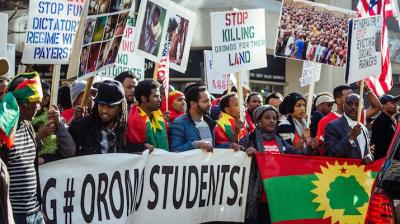Eye of the Storm: Ethiopia Amid Middle Eastern Conflict
The state of conflict in the Middle East is depressing and frightening at the same time. It also harbours significant indirect risks for Ethiopia. The Middle East’s bloodiest civil war – in Syria – is likely to continue for some time. President Assad has ‘won’ the war by not losing it. But he has neither re-established his hold over the populous region of Idlib nor a number of oil and gas fields in the east. Yet, these are essential to financing the country’s reconstruction. It is also in this area that geopolitical competition between Iran and the United States (US) is fiercest.
At the same time, the civil war in Iraq may re-ignite. The Islamic State is almost defeated, but the recent Kurdish referendum for independence has thrown up a new challenge. Skirmishes between Kurdish Peshmerga and Iraqi units have already occurred around the city of Kirkuk. Lebanon’s political crisis also endures with Saudi Arabia and Iran sponsoring different political factions. This gives them an opportunity to meddle in Lebanon itself, but also in Syria and Palestine given the many refugees and transnational actors like Hezbollah.
Meanwhile, more than twenty years after the Oslo Accords, the Israeli-Palestinian conflict continues due to Israeli intransigence and Palestinian division. In a volatile region, its injustices and discrimination serve as powerful beacons for violence and radicalisation. Adding to this is Turkey’s anti-insurgency campaign against the Kurdistan Workers’ Party (PKK) that is further dividing the country and corroding its democracy, while the socio-economic siege of Qatar by its fellow members of the Gulf Cooperation Council continues apace as well.
Closest to Ethiopia, the war in Yemen shows no signs of abating. There are indications that Saudi Arabia wants to pull out, but this will be hard given the chaos, factionalism and the humanitarian catastrophe intervention has helped to create.
What connects these developments?
One critical link is the regional rivalry between Saudi Arabia and Iran. This is less about Sunni versus Shi’a divisions and more a classic competition for power and influence. Worryingly, it is about to get worse. President Trump’s decertification of Iranian compliance with the Joint Comprehensive Program of Action (JCPOA) may lead to further US sanctions. If this happens, Iran will be free to continue developing its nuclear capacity – but this time without becoming a global pariah, as the rest of the world begs to differ with US policy on this matter.
Another vital link is the reduction of the US footprint in the Middle East and its singular focus on Sunni extremism. This opens space for regional powers like Turkey, Egypt, Saudi Arabia and Iran to compete more forcefully. Besides, the selectivity of US military intervention sets the scene for further conflict as it leaves many causes unaddressed, including poor governance, sectarian relations and historical grievances.
Ethiopia has its own immediate neighbourhood to worry about, but it would be a mistake to think that developments in the Middle East will not affect it. To the contrary, in particular, the expanding Saudi-Iranian rivalry could have serious repercussions for Ethiopia. This includes more hostile Eritrean behaviour towards Ethiopia, greater religious challenges in Ethiopia itself and an increased presence of Gulf countries in the Horn of Africa.
Closest to home, Eritrea is benefiting from having joined the Saudi-led coalition in Yemen. In Saudi’s eyes, the war in Yemen serves to ward off an Iranian presence by proxy on its southern border in the form of the Houthi. Although evidence supporting this view is scant, Saudi perceptions of Iranian threat and encirclement are real. The fact that Yemen is key to shipping Saudi imports and exports through the Gulf of Aden probably also plays a role, given Iran’s ability to close the strait of Hormuz.
Unfortunately, in a sense, Saudi Arabia has vast resources to respond, and it has recently channelled these into a foreign policy that is much more muscular than its usual suave diplomacy. But in international affairs, muscle requires a pretext. In Yemen, the Saudi’s have created this by establishing a coalition of the ‘paid-for’ that is said to fight terrorism. This generates a financial lifeline for both Eritrea and Egypt. Both countries also benefit from anti-migration funds that the European Union is carelessly sprinkling throughout Africa, for example through the EU Trustfund for stability and migration. Practically, this reduces Eritrea’s international isolation and increases its heft. Given Eritrea’s long history of supporting violent opposition groups in Ethiopia, this is a development to watch. Also, Egypt might convince Saudi Arabia to side with it in diplomatic disputes with Ethiopia over the use of Nile waters.
In addition, the Saudi-sponsored export of Salafi religious thought via mosques, schools and charities has also affected Ethiopia’s circa 30 million Muslims. Generally speaking, societies in the Sahel that have experienced long-term exposure to well-funded Salafi outfits feature greater social conservatism as well as religious actors with growing political power.
Were Saudi external financial support to grow in function of its rivalry with Iran, such trends could accelerate and lead to greater strife within Ethiopia’s Muslim community. Alternatively, given the historical marginalisation of this community, key leaders could be tempted to use it to push their own political agenda vis-à-vis the Ethiopian state. This could include challenging the authority of Ethiopia’s centralised system of governance.
Finally, there has been a significant level of Gulf economic involvement in the Horn of Africa of late. This is a mix of investment, land acquisition and establishing military infrastructure. For example, Saudi Arabia has been acquiring significant tracts of lands in Ethiopia. Also, Djibouti, the main gateway for Ethiopian trade, now hosts a Saudi military base. Finally, the Emirates (a Saudi ally) are investing in Berbera and may open a military base there as well.
The nature of such economic involvement tends to be that smaller and needier recipient countries freeze their diplomatic ties with Iran in exchange for Gulf largesse, in effect trading part of their foreign policy for economic benefits. As Iranian-Saudi rivalry deepens, such investment may grow in a bid to create a strategic hinterland to the conflicts in the Middle East and to garner political support for the diplomatic battles to come. Where such investments create economic dependencies – which is not difficult given the state of poverty in the Horn, including in Ethiopia – the scope for independent foreign policy will be reduced.
Against this backdrop, two actions would seem prudent for the Ethiopian government to consider. First, it ought to put into place affirmative action policies that are necessary to reduce the historical marginalisation of Ethiopia’s Muslim community. A greater effort also could be expanded to ensure this community benefits from its own, relatively autonomous, but moderate governance in religious matters. Such action resonates well with the logic of Ethiopia’s Foreign Affairs & National Security Policy & Strategy (FANSPS) that considers the world through the prism of domestic threats.
Second, the Ethiopian government should also consider moving beyond this inside-out focus of its foreign and security policy by re-considering relations with Eritrea as a strategic foreign policy challenge in its own right. The key question here is how it can prevent future hostility from a reinvigorated Eritrean government without damaging its mediation and peacekeeping reputation in the Horn.
Ethiopia is a ‘taker’ - not a ‘shaper’ - of developments in the Middle East, but it will have to up its diplomatic engagement in its own neighbourhood as well as in the Gulf to manage such risks and turn them into opportunities.
This opinion was published in Addis Fortune vol. 18, no. 912 on October 21, 2017.





